Abstract
Using first-principle spin-density functional computations, the structural, magnetic, and electronic properties of the Cr- and V-doped diluted magnetic semiconductors Ca1-xCrxS and Ca1-xVxSe at x = 0.25 in the B1 (NaCl) phase are explored. Elastic constants and structural properties (lattice constants, bulk modulus, and its pressure derivative) were calculated and used to establish structure stability. Plots of the TDOS and PDOS of transition metal atom-doped CaZ at x = 0.25 and pure CaZ (Z = S, Se) are presented. Cr-doped CaZ (Z = S, Se) shows half-metallic character at x = 0.25 and is stable in ferromagnetic state, while that of V-doped CaZ compounds shows semiconductor behavior and is stable in antiferromagnetic state. Dispersion of phonons was also evaluated to check the global minima of energy in pure CaZ compounds. Curie temperature, magnetic moments, and exchange constants were also calculated for all doped systems. The current results are in excellent agreement with earlier research. Our current findings imply that CaZ doped with Cr/V (Z = S, Se) would make a promising option for spintronic applications.
1. Introduction
Spintronics has advanced over the last two decades, and several investigations employing various ab initio methods have been carried out on DMS and DMO in an effort to identify new, more effective materials with intriguing physical characteristics, including ferromagnetic stability and high Curie temperature. These nonmagnetic DMSs are doped lightly with small amounts of magnetic impurities in the host structure. The actual development of these materials in material science is challenging because a compound must have both electronic and magnetic doping, and the interaction between electronic carriers and magnetic dopants must be thermally stable [1]. Early investigations in the field of DMS began with research on II–VI semiconductors. It was found that a modest amount of magnetic atom doping had no effect on the electrical, transport, or optical properties of the fundamental material. Instead, it introduces effects of magnetic fields in nonmagnetic materials [2]. Zn1−xMnxTe and Cd1−xMnxTe were the first II–VI semiconductor alloys that were known. These ternary alloys attracted significant interest in the scientific community as we can tune material properties of the compounds by changing their composition. The lattice constant, energy band gap, and effective mass of the carriers are all easily modifiable in II–VI compounds. Dilute magnetic semiconductor materials are high-performance materials as magnetic impurities in considerable amounts produce magnetic and cooperative phenomena such as spin–exchange interactions [3,4,5,6,7]. Due to the stability of their magnetic phase, the magnetic diluted industry has gained lot of interest in these types of compounds. In the year 1960, the compounds, which were Cr-doped II–VI semiconductors, were being used in a number of optical devices such as LEDs, lasers, and fluorescent displays [8]. In 2020, the electronic structure and magnetic properties of diluted Ca1−xTMxS (TM = V, Cr, and Co) in the rock salt structure at three concentrations (0.25, 0.125, and 0.0625) were proposed by Amina Aiche et al. [9] while studying the electronic structure of Ca1−xCrxS and Ca1−xVxS, and it was found that these compounds show half-metallic ferromagnetism behavior with 100% spin polarization at all concentrations, whereas Ca1−xCoxS possessed half-metallic ferromagnetic character at 0.0625 doping concentration. Half-metallic ferromagnetism with 100% spin polarization makes these compounds attractive for potential applications in the spintronic field. Similarly, half-metallic ferromagnetic behavior of Ca1−xTMxSe (TM = V, Cr, and Mn) with complete spin polarization of 100% at Fermi level was predicted by Youcef Daoudi et al. in 2021 [10]. The computed band structures and density of states indicates that these compounds are suitable candidates for possible applications in the spintronic field. On the other hand, Meryam et al. explored the new dilute magnetic semiconductor compound Ca1-xTixS using the FP-LAPW method based on SP-DFT. Along with this, it was predicted that these compounds exhibit half-metallic ferromagnetic demeanor [11]. Moreover, Hamidane et al. [12,13] reported the half-metallic ferromagnetic properties of II–VI-semiconductor-based DMS compounds such as V- and Cr-doped CaS using first-principle calculations, confirming the half-metallic ferromagnetism behavior in these compounds.
In particular, the appearance of half-metallic ferromagnetism in Ti-doped II–VI semiconductors such as Sr0.75Ti0.25X (X = S, Se, and Te) [13], make it a favorable system for spintronic devices. While studying structural and magneto-electronic performance of Ba1−xCrxS, they discovered the half-metallic characteristic with ferromagnetic state of these compounds with better magnetoelectronic performances, which makes them appropriate materials for spin-injection applications [14]. In 2021, Youcef Daoudi et al. [15] studied Ca1−xTMxTe (TM = V, Cr, Mn) compounds with concentration of x = 0.25, 0.125, and 0.0625. They discovered that half-metallicity of Cr-doped CaTe is due to p–d hybridization around Fermi level, and the ferromagnetic ground state of Ca1-xCrxTe could be explained by a double exchange mechanism. Further, exchange constants have a substantial role in producing half-metallicity in Cr-doped compounds and make them promising candidates for the spintronic devices.
Calcium chalcogenides are wide bandgap semiconductors [16]. These are widely used in thermo/electro/photoluminescence as well as phosphorescent and other optoelectronic materials due to their broad applications in catalysis to microelectronics and optoelectronics [17,18,19]. Under ambient conditions, they prefer to be crystallized in a B1-type structure [20].
Analyzing the literature thoroughly reveals that it is important to find the compounds which possess stable half-metallic ferromagnetism and high Curie temperature. This motivates us to study the V/Cr-doped CaZ (Z = S, Se) materials. In this paper, we focused on 0.25 concentration of TM dopants. We computed their structural, elastic, electrical, Curie temperature, and magnetic properties. Our paper consists of the following sections: the computational method used in the present work is described in Section 2. In Section 3, in our discussion of V/Cr-doped CaZ (Z = S, Se) compounds, we cover the ground state characteristics, electronic structure, elastic parameters, phonon dispersion, and magnetic properties. A conclusion is given in the final section.
2. Computational Details
The present calculations of Ca1−xCrxS and Ca1−xVxSe at x = 0.25 were performed using computer code SIESTA [21]. The structural, electrical, magnetic, and elastic properties of V- and Cr-doped CaS and CaSe DMSs were calculated using DFT, and total energy calculations were performed using GGA as an XC functional [22] in the form provided by the Perdew–Burke–Ernzerhof (PBE) scheme. Ca, S, Se, Cr, and V have the pseudoelectronic configurations 3s2 3p6 4s2 3d0, 3s2 3p4, 4s2 4p4, 3d5 4s1, and 4s2 3d3. The cutoff energy and number of k-points in the B1 structure of CaS and CaSe compounds was optimized. As a result, a plane-wave basis set with an energy cutoff of 100 Ry was employed for Brillouin zone sampling, and a 10 × 10 × 10 Monkhorst–Pack [23] k-point grid was used for the B1 phase. In the B1 (NaCl) phase, Ca atoms occupy places (0.00, 0.00, 0.00), while S/Se atoms occupy positions (0.50, 0.50, 0.50). By replacing one Ca cation with one Cr/V atom, we were able to create the Ca0.75T0.25Z (T = Cr, V; Z = S, Se) ternary compounds. The Ca0.75T0.25Z (T = Cr, V; Z = S, Se) features an 8-atom unit cell with a cubic structure (1 × 1 × 1). In order to determine the stability of ferromagnetic states in DMSs, we calculated the energy difference between the ferromagnetic and antiferromagnetic states, i.e., ΔEAFM − ΔEFM. The system is stable in the FM state when the energy difference is positive; otherwise, it is in the AFM state. The Curie temperature was calculated considering the total energy difference between the FM and AFM states. Formation energy was also evaluated. Using exchange coupling constants, the magnetic characteristics of the ternary alloys Ca0.75T0.25Z (T = Cr, V; Z = S, Se) were investigated. The spin-polarized calculations and geometric relaxations were found using the DZP (double-zeta plus polarization) basis set and CG (conjugate-gradient) method. This was accomplished by thorough structural optimization unless the forces were less than 0.04 eV/Å.
3. Result and Discussion
3.1. Structural Properties
In proximity of the parent CaS and CaSe semiconductors’ lattice parameters, the ground state optimization for Ca0.75T0.25Z (T = V, Cr; Z = S, Se) compounds was performed. To start the process, the total energy of the AFM and FM states in three different configurations were established that correspond to various distances of the V- and Cr-doped CaS and CaSe compounds as shown in Table 1. Here, we set the initial V/Cr atom’s location (position “0”), and positions 1, 2, and 3 of the second V/Cr atom were chosen at random. Configuration (0,1) for Ca0.75V0.25Z represents that the initial position of the first V-doped atom is given by the “0” symbol and “1” represents the position of second V-doped atom in a unit cell of size 2 × 2 × 1. Similarly, configurations (0,2), (0,3), and (0,4) represent the positions of doped transition metal atoms (V/Cr) at different positions in the unit cell. We calculated the distances dd1 and dd2 before and after relaxing for the models under consideration. It was found that the total energy differences between the AFM and FM states for Ca0.75V0.25Z (Z = S, Se) and Ca0.75Cr0.25Z (Z = S, Se) are negative and positive, respectively. This suggests that the Cr-doped CaZ’s ferromagnetic state is more stable [24], whereas CaZ that has been doped with V remains antiferromagnetic.

Table 1.
V–V and Cr–Cr distance before (dd1) and after relaxation (dd2), magnetization energy (ΔE = EAFM − EFM).
The following relation is used to determine the Curie temperature from the total energy difference ΔE:
where KB represents the Boltzmann constant and x represents the dopant concentration.
Furthermore, to establish structure stability, Murnaghan’s equation was utilized to obtain the optimized value of the lattice constant A, bulk modulus B, and other elastic constants [25].
3.1.1. Elastic Properties
In this study, the mechanical stability of binary and ternary compounds was investigated using second-order elastic constants. The structure has the space group Fm3m. C11, C12, and C44 are the only three independent elastic constants in the FCC structure. The values of the elastic constants were calculated using the following matrix [26]:
These three elastic constants were calculated using suitable deformations which are as below:
D1 is an orthorhombic distortion that conserves volume and D2 alters the a-lattice lattice parameter. The distortion lattice’s volume varies using D2, but the strained lattice’s symmetry stays cubic. The energy of the volume-preserving monoclinic distortion D3 may be computed as follows [27]:
Finally, a polynomial fitting method was used to obtain the second-order elastic constants. The three equations listed above were resolved using least square fit using the derived elastic constants. Table 2 and Table 3 show the elastic moduli results for pure and TM-doped CaS and CaSe.

Table 2.
Calculated lattice constants, elastic constants, and elastic moduli of pure and TM-doped CaS.

Table 3.
Calculated lattice constants, elastic constants, elastic moduli, compressibility, and anisotropy for pure and TM-doped CaSe.
The computed value of the lattice constant of pure CaS and CaSe was found to be comparable to experimental and other theoretical data. Table 2 and Table 3 indicate that the value of the lattice constant drops in V/Cr-doped CaS and CaSe. The reason for this is that the atomic radius of doped atoms is smaller than that of the host Ca atom. The Ca atom has an atomic radius of 231 pm, while V and Cr atoms have atomic radii of 205 pm and 128 pm, respectively. In pure CaZ systems, as well as in V and Cr-doped CaZ (Z = S, Se) systems, the values of the elastic constants C11, C12, and C44 similarly drop from S to Se.
To determine the isotropic elastic constants, three averaging approaches are implemented. In the Voiget method, uniform strain is assumed, and Russ technique is used in the event of uniform stress. Hill [35] showed that Voigt and Reuss elastic moduli are the strict upper and lower bounds, respectively. The Hill average bulk modulus may therefore be computed from the elastic moduli of Voigt and Ruess as BH = (BR + BV)/2, where BV = (1/9)[(C11 + C22 + C33) + 2 (C12 + C23 + C31)]; in addition, BR = [(S11 + S22 + S33) + 2(S12 + S23 + S31)]−1; Sij (=Cij−1) are the elastic compliance constants [35]. The bulk moduli of Voigt and Reuss are comparable for cubic crystal structures C11 = C22 = C33 and C12 = C23 = C31, BR = BV = (C11 + 2C12)/3. This property is illustrated in Table 2 and Table 3, and BR = BV = BH for pure and doped systems. This is true only for cubic symmetry. The data also show that derived values of bulk modulus from elastic constants, BH = (C11 + 2C12)/3 for all systems, are extremely near to values obtained from Murnaghan’s equation of state Beq by fitting the E–V curves with a discrepancy of less than 2%. This might be substantial evidence for the correctness and reliability of the existing estimates of the elastic constants for CaS, CaSe, and Ca0.75T0.25Z (T = V, Cr; Z = S, Se). It has been observed that the compressibility of pure and doped CaSe is greater than that of CaS. CaSe systems are therefore more compressible than pure CaS and doped CaS systems. Mechanical stability requires elastic constant limits such as C11 − C12 > 0, C11 + 2C12 > 0, C11 > 0, C12 < C11, and C44 > 0 [26,27,28,29,30,31,32,33,34,35,36,37,38]. The evaluated elastic constants in this work satisfy all of these conditions for stable B1 structures. The cubic stability condition is also satisfied by the estimated elastic constants, i.e., C12 < B < C11.
3.1.2. Phonon Dispersion Curves
We calculated the dispersion of phonons in pure CaS and CaSe semiconductors to check the global minima of energy. HF forces were used to calculate the force constants which were induced due to the displacement of atoms. The size of the supercell is utilized to determine phonon frequencies at each location of the Brillouin zone Γ, X, L, M. In the present work for the calculations of dispersion of phonons, supercell of size (1 × 1 × 1) was considered. Phonon dynamics also helps to evaluate the macroscopic behavior of solids, e.g., thermal expansion, specific heat, etc. Furthermore, very low frequency modes can be related to a phase transition, whereas imaginary frequencies indicate that the estimated structure is inherently unstable. Figure 1 and Figure 2 indicate that our computed phonon frequencies are positive, indicating that the structure of CaS and CaSe considered for subsequent calculations is stable.
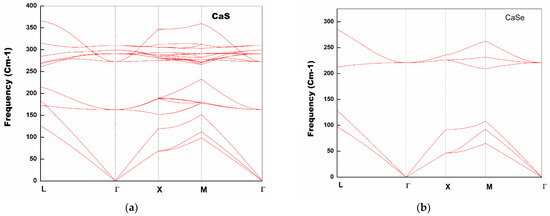
Figure 1.
(a): Phonon dispersion curves for CaS and (b) CaSe semiconductor [39].
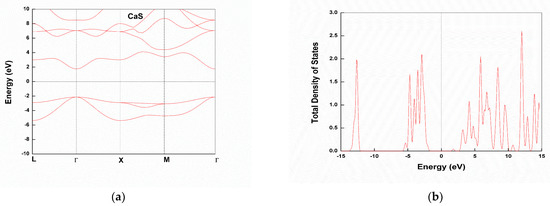
Figure 2.
(a) Electronic band structures and (b) total density of states of CaS [22,40].
3.2. Electronic Structure
We performed simulations to determine the electrical and magnetic characteristics of pure and V/Cr-doped CaS and CaSe compounds after confirming structure stability. Understanding electronic band structure is tremendously important for spintronics. Using an optimum lattice parameter, the electronic band structures and total density of states of pure and doped materials were investigated. As shown in Figure 2 and Figure 3, we first calculated the band structures and total density of states of pure CaS and CaSe semiconductors along various symmetry lines in the Brillouin zone. The horizontal line in band structure and the vertical line in TDOS at E = 0 eV represent the Fermi level. The investigation of band structures reveals that the conduction band minima (CBM) and valence band maxima (VBM) for both substances, CaS and CaSe, are located at the Γ point. We found that CaS and CaSe have 3.84 eV direct band gaps and 3.27 eV in the B1 phase at ambient pressure, respectively, which agrees with other theoretical predictions listed in Table 3.
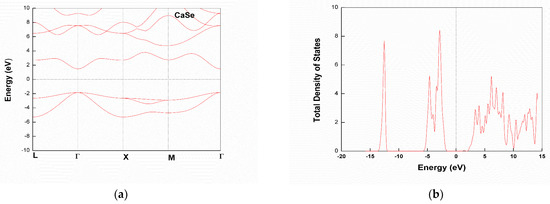
Figure 3.
(a) Electronic band structures and (b) total density of states of CaSe [40].
Furthermore, the total and partial density of states, as well as the spin-polarized band structures, of V/Cr-doped CaS and CaSe semiconductors at x = 0.25 in B1 phase were also determined. Spin-polarized band structures with TDOS Cr-doped CaS and CaSe diluted magnetic semiconductors are shown in Figure 4 and Figure 5, respectively, and V-doped CaS and CaSe DMSs in B1 phase for spin-up and spin-down states, with high symmetry directions in the Brillouin zone, are shown in Figure 6 and Figure 7. The forbidden gap in the majority spin channel (MAC) is shown in Figure 4 and Figure 5 to be completely filled with impurity atom energy levels, suggesting that the studied compound exhibits a metallic character in the MAC. These impurity energy levels are generated by Cr-3d states, which generate a significant number of electron traps. As a result, they significantly improve electrical conductivity and optical characteristics of CaS semiconductors. In contrast, the conduction band minima and valence band maxima of a minority spin channel (MNC) are both found at the Γ K-point. As a result, these compounds exhibit semiconductor behavior in the minority channel. As a result, at x = 0.25, Cr-doped CaS and CaSe compounds exhibit half-metallic behavior in the B1 phase. The bottom energy of the minority (dominant) spin conduction band is subtracted from the fermi level to determine the half-metallic band gap. Table 3 shows the predicted half-metallic gaps of minority spin channels (GHM) of Cr-doped CaS and CaSe. The total density of states (TDOS) of Ca0.75Cr0.25S and Ca0.75Cr0.25Se alloys are also useful in establishing the band state character. The maximum of the valence band crosses the Fermi energy level in the majority channel, as seen by the total density of states in Figure 4 and Figure 5, but the maximum of the valence band remains below the Fermi energy level and the bottom of the conduction band remains above the Fermi energy level in the minority spin state, implying that Cr-doped CaS and CaSe in the spin-up state exhibit metallic behavior and in the spin-down state exhibit semiconductor behavior.
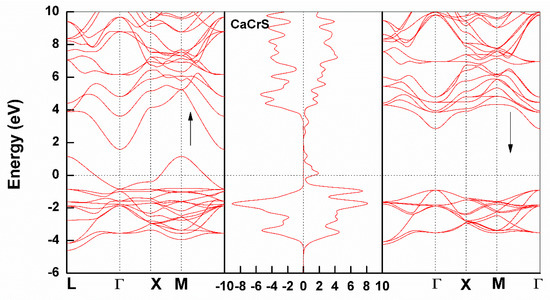
Figure 4.
Spin-polarized band structure of Ca0.75Cr0.25S.

Figure 5.
Spin-up and spin-down band structure of Ca0.75Cr0.25Se.
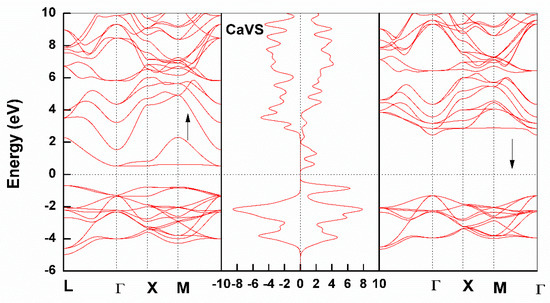
Figure 6.
Spin- up and Spin – down band structure of Ca0.75V0.25S.
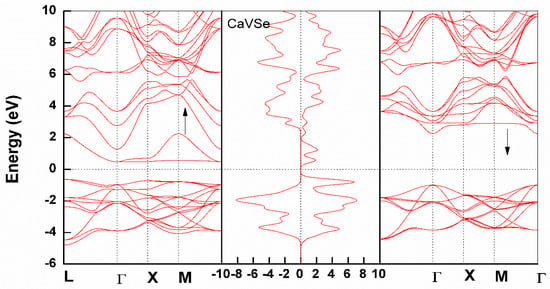
Figure 7.
Spin- up and spin-down band structure of Ca0.75V0.25Se.
Figure 6 and Figure 7 show that in in Ca0.75V0.25S and Ca0.75V0.25Se, valence band maxima and conduction band minima in MAC and MNC both lie at the K-point Γ, indicating that direct band gaps exist in V-doped CaS and CaSe compounds at Γ point and both DMSs exhibit semiconductor behavior. Table 4 shows the computed spin-up and spin-down band gaps of Ca0.75V0.25S and Ca0.75V0.25Se diluted magnetic semiconductors at x = 0.25. Total density of states (TDOS) Ca0.75V0.25S and Ca0.75V0.25Se are also useful in demonstrating the semiconductor behavior of these alloys. Total density states shown in Figure 6 and Figure 7 show that in V-doped CaS and CaSe, in spin-up and spin-down states no electronic energy state occurs at Fermi energy level. CaVS and CaVSe DMSs exhibit semiconductor behavior in the B1 phase at x = 0.25.

Table 4.
Spin-up and spin-down and half-metallic band gaps of V/Cr-doped CaZ (Z = S, Se).
Partial Density of States
The partial density of states for Ca1-xCrxS and Ca1-xCrxSe at x = 0.25 in B1 phase is depicted in Figure 8 and the overall density of states was decomposed into s-, p-, and d- orbital contributions to perform a qualitative investigation of each set of energy bands of Ca1-xCrxS and Ca1-xCrxSe.
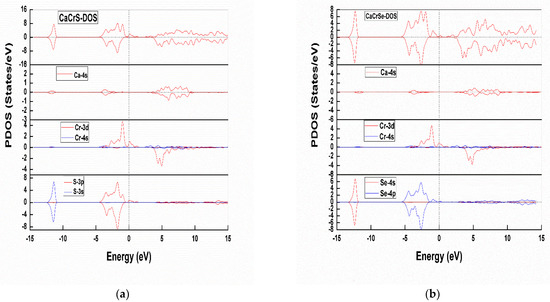
Figure 8.
(a) Partial density of states of Ca0.75Cr0.25S and (b) Ca0.75Cr0.25Se.
In S and Se, valence electrons are s- and p-state electrons. The remaining electrons, on the other hand, are considered to be part of the core. Figure 8 indicates that the 3s states of S, with a tiny contribution from 4s states of Ca, of the valence band are in the lowest section in Ca0.75Cr0.25S.
There is a minor contribution of 3p states of S in the top section of the valence band, which is near the Fermi level. Cr-3d states play a key role in the upper area of the valence band, but in the spin-up condition, these are near the Fermi surface. In the spin-down situation, these states are a few electron volts below the Fermi surface. Ca-4s states dominate the bottom of the conduction band, with a tiny contribution from S-3s states in the spin-up condition and Ca-4s and Cr-3d states in the spin-down situation. The energy difference between the spin-up and spin-down peaks due to effective Cr-3d states is characterized as the spin–exchange splitting energy. The lowest half of the valence band in Cd0.75Mn0.25Se is attributable to Ca-4s states with a tiny contribution from Se-4s states, whereas the upper part of the valence band is filled with Ca-4s, Se-4p, and Cr-3d states. Cr-3d states are present around the fermi level in spin-up states, but a few eV below the Fermi level in spin-down states. In the conduction band, which lies above the Fermi surface, the bottom of the conduction band is occupied with Ca 4s and Se-4p states for spin-up states, and Cr-3d and Ca-4s states for spin-down states.
Furthermore, substitution of a transition metal atom on the semiconductor’s cation site degenerates the 3d atomic levels of Cr atom in Ca0.75Cr0.25S and Ca0.75Cr0.25Se, degenerating into three degenerate t2g states and two doubly degenerate e2g states, as illustrated in Figure 9. These states are separated by tetrahedral crystal field splitting caused by the Ca cation and the S/Se anion. In general, both the eg and t2g states are in the valence band for majority spin. In these systems, a percentage of t2g states in majority spin states cross the Fermi level, whereas it is completely in conduction in minority spin states. It can also be noticed that the Fermi level only crosses the peak in one direction, suggesting that Ca0.75Cr0.25S and Ca0.75Cr0.25Se are half-metallic in nature.
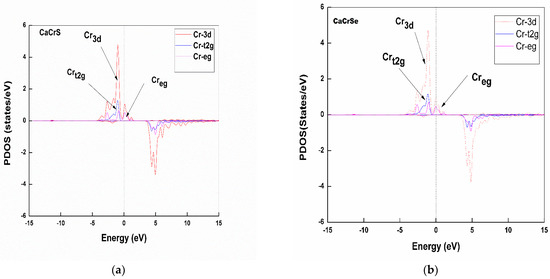
Figure 9.
Partial density of states of Cr-3d states in (a) CaCrS and (b) CaCrSe.
Figure 10 shows that in Ca0.75V0.25Se, Ca-4s states, with a small contribution from S-3s states, dominate the bottom portion of the valence band, while Ca 4s and S-3p levels at the Fermi surface control the upper portion of the valence band. For spin-up states, V-3d states can be observed in the upper section of the valence band. For spin-up states, they are close to the Fermi surface, while for spin-down states, they are a few electron volts below the Fermi surface. In the spin-up situation, Ca 4s states dominate the bottom of the conduction band above the Fermi surface, whereas in the spin-down situation, Ca 4s and V-3d states dominate.
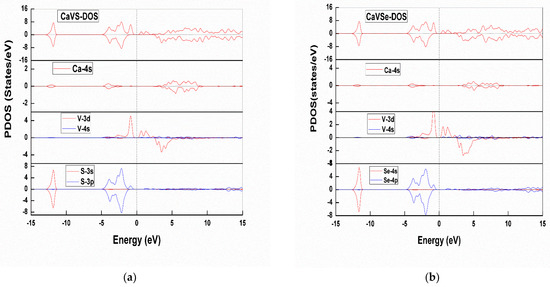
Figure 10.
(a) Partial density of states of Ca0.75V0.25S and (b)Ca0.75V0.25Se.
Crystal field theory states that when V transition metal ions replace the cationic sites of CaZ (Z = S/Se), the tetrahedral crystal field created by the S/Se ion splits the fivefold degenerate 3D states of the transition metal ions into three high-lying t2g (dxy, dyz, dzx) and two low-lying (dx2-y2, dz2) symmetries, as shown in Figure 11. Ca0.75V0.25S and Ca0.75V0.25Se are found to be semiconductors in nature since the Fermi level does not pass any peak in either direction.
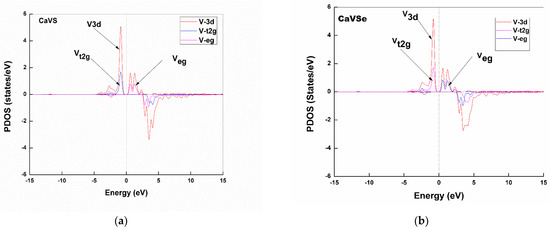
Figure 11.
Partial density of states of V-3d states in (a) CaVS and (b) CaVSe.
3.3. Magnetic Properties
The magnetic characteristics of V/Cr-doped CaZ (Z = S, Se) DMSs were studied using exchange constants. We evaluated N0α and N0β exchange constants. The s–d exchange constant is N0α, while the p–d exchange constant is N0β. The cation concentration is N0. The interaction between V/Cr spin and conduction electron carriers is shown by N0α (s–d exchange constant), whereas the interaction between V/Cr spin and holes is defined by N0β (s–d exchange constant). Valence and conduction band edge splitting are important in the exchange and splitting process. These exchange constants can also be evaluated experimentally using spin split exciton bands and optical-magneto absorption experiments [41]. Total magnetic moments, local magnetic moments, exchange constants, and valence and conduction band edge splitting are all determined in Table 5. The following formulas were used to determine exchange constants [42]:
where ΔEC and ΔEv are band edge splitting of conduction band minima (CBM) and valence band maxima (VBM), x is the concentration of V/Cr atom, and <S> is one half of the magnetization per V/Cr ion.

Table 5.
Calculated values of band edge splitting of CBM and VBM, exchange constants, and total and local magnetic moments.
The total magnetic moment of 3d electrons inside the Cr sphere in CaCrS and CaCrSe is 4.00 µb, while the total magnetic moment of 3d electrons within the V sphere in CaVS and CaVSe is 3.00 µb, as shown in Table 5. DMSs create permanent local magnetic moments due to partly filled Cr 3d/V-3d levels. Other fascinating features of DMSs result from exchange interactions between magnetic ions and electrons or holes near the band boundaries [42,43,44,45,46,47]. On nonmagnetic Ca, S, and Se atoms, a Cr/V atom induces a local magnetic moment. The magnetic moments of Ca, S, and Se atoms are all negative, suggesting that their magnetic moments are antiparallel. The magnetic moments of S/Se and Ca atoms are also the result of Cr/V and Cs S/Se orbital hybridization.
4. Conclusions
The structural, vibrational, elastic, electronic, and magnetic characteristics, as well as the Curie temperature, of pure and transition metal atoms V/Cr-doped CaS and CaSe semiconductors were investigated using density functional theory. Our calculated phonon frequencies for CaS and CaSe semiconductors are positive in nature which shows that compounds are dynamically stable. It is found that Cr-doped CaS and CaSe DMSs are ferromagnetically more stable than in the antiferromagnetic state, whereas Ca0.75V0.25S and Ca0.25V0.75Se compounds are stable in the antiferromagnetic state. It was also established that the Fermi level crosses the peak in just one direction in Cr-doped CaS and CaSe DMSs, which implies that Ca0.75Cr0.25S and Ca0.25Cr0.75Se compounds show half-metallic behavior. On the other hand, V-doped CaS and CaSe show semiconductor behavior, where the Fermi level does not cross any peak. Double exchange in the ferromagnetic phase is the mechanism responsible for its stability in Ca0.75Cr0.25S and Ca0.25Cr0.75Se, while the super exchange coupling is responsible for the stability of the antiferromagnetic state in Ca0.75V0.25S and Ca0.25V0.75Se. We also evaluated the Curie temperatures for V/Cr-doped CaS and CaSe at different positions of the dopant atoms, and distance was also evaluated before and after the optimization. At ambient pressure, the elastic constants of pure and doped systems in B1 phase were computed. The estimated elastic constant values indicate that these compounds are mechanically stable.
Author Contributions
R.K.: Conceptualization, writing, and supervision; A.R.: Computation, analysis, and writing; A.A.A.: Analysis, editing, and writing. All authors have read and agreed to the published version of the manuscript.
Funding
This research was funded by Deanship of Scientific Research (DSR), King Abdulaziz University, Jeddah, Saudi Arabia, under Grant No. (G: 600-130-1443).
Data Availability Statement
Data will be available on request.
Acknowledgments
The authors gratefully thank the Distinct Research Study project, which was supported by the Deanship of Scientific Research (DSR), King Abdulaziz University, Jeddah, Saudi Arabia, under Grant No. (G: 600-130-1443). The authors, therefore, feel deeply grateful to DSR for technical and financial support.
Conflicts of Interest
The authors declare no conflict of interest.
References
- Chambers, S.A.; Droubay, T.C.; Wang, C.M.; Rosso, K.M.; Heald, S.M.; Schwartz, D.A.; Kittilstved, K.R.; Gamelin, D.R. Ferromagnetism in oxide semiconductors. Mater. Today 2006, 9, 28. [Google Scholar] [CrossRef]
- Furdyna, J.K. Diluted Magnetic Semiconductors. J. Appl. Phys. 1988, 64, R29. [Google Scholar] [CrossRef]
- Ramdas, A.K.; Rodriguez, S. Raman Scattering by Magnetic Excitations in Diluted Magnetic Semiconductors. MRS Online Proc. Libr. 1986, 89, 49–58. [Google Scholar] [CrossRef]
- Ohno, H.; Munekata, H.; Von Molnar, S.; Chang, L. Diluted magnetic III-V semiconductors. J. Appl. Phys. 1991, 69, 6103. [Google Scholar] [CrossRef]
- Tsai, C.; Chen, S.; Chuu, D.; Chou, W. Fabrication and physical properties of radio frequency sputtered Cd1-xMnxS thin films. Phys. Rev. B 1996, 54, 11555. [Google Scholar] [CrossRef] [PubMed]
- Rodic, D.; Spasojevic, V.; Bajorek, A.; Orinerud, P. Similarity of structural properties of Hg1-xMnxS and Cd1-xMnxS. J. Magn. Magn. Mater. 1996, 152, 159. [Google Scholar] [CrossRef]
- Li, J.; Xu, X.; Zhou, Y.; Zhang, M.; Luo, X. First-principles investigation on the electronic and magnetic properties of cubic Be0.75Mn0.25X (X = S, Se, Te). J. Alloys Compd. 2013, 575, 190. [Google Scholar] [CrossRef]
- Nazir, S.; Ikram, N.; Siddiqi, S.A.; Saeed, Y.; Shaukat, A.; Reshak, A.H. First principles density functional calculations of half-metallic ferromagnetism in Zn1-xCrxS and Cd1-xCrxS. Curr. Opin. Solid State Mater. Sci. 2010, 14, 6. [Google Scholar] [CrossRef]
- Aiche, A.; Tadjer, A.; Mazouz, H.M.A.; Doumi, B.; Khachai, H. Electronic Structure and Ferromagnetic Properties of Doped Calcium Sulfide Ca1−xTMxS (TM == V, Cr and Co). SPIN 2020, 10, 2. [Google Scholar] [CrossRef]
- Daoudi, Y.; Mazouz, H.M.A.; Lagoun, B.; Benghia, A. Structural, Electronic and Magnetic Properties of CaSe Doped with 3d (V, Cr and Mn). SPIN 2021, 11, 2150026. [Google Scholar] [CrossRef]
- Ziati, M.; Ez-Zahraouy, H. Theoretical Investigation of Structural, Electronic Properties and Half-Metallic Ferromagnetism in Ca1−xTixS ternary alloys. J. Supercond. Nov. Magn. 2021, 34, 1441–1452. [Google Scholar] [CrossRef]
- Hamidane, O.; Meddour, A.; Bourouis, C. Half-metallic ferromagnetism character in Cr-doped CaS diluted magnetic insulator and semiconductor: An ab initio study. J. Supercond. Nov. Magn. 2019, 32, 2155–2164. [Google Scholar] [CrossRef]
- Hamidane, N.; Baaziz, H.; Ocak, H.; Kmaml, B.U.; Sule, U.; Gokay, Z. Charifi Ab Initio Full-Potential Study of the Structural, Electronic, and Magnetic Properties of the Cubic Sr0.75Ti0.25X (X = S, Se, and Te) Ternary Alloys. J. Supercond. Nov. Magn. 2020, 33, 3263–3272. [Google Scholar] [CrossRef]
- Doumi, B.; Boutaleb, M.; Mokaddem, A.A. Investigation of the structural properties and the magneto-electronic performances in new Ba1-xCrxS materials. Opt. Quant. Electron. 2022, 54, 747. [Google Scholar] [CrossRef]
- Daoudi, Y.; Mazouz, H.M.A.; Fadla, M.A.; Benghia, A. Ab intio investigation of electronic and magnetic properties of Ca TM Te (TM = V, Cr, and Mn). J. Magn. Magn. Mater. 2021, 538, 168315. [Google Scholar] [CrossRef]
- Kaneko, Y.; Koda, T.N. New Developments in IIa–VIb (alkaline-earth chalcogenide) binary semiconductor. J. Cryst. Growth 1988, 86, 72–78. [Google Scholar] [CrossRef]
- Louail, L.; Haddadi, K.; Maouche, D.; Sahraoui, F.A.; Hachemi, A. Electronic band structure of calcium selenide under pressure. Phys. B Condens. Matter. 2008, 403, 3022–3026. [Google Scholar] [CrossRef]
- Versluys, J.; Poelman, D.; Wauters, D.; Meirhaeghe, R.L.V. Photoluminescent and structural properties of CaS: Pb electron beam deposited thin films. J. Phys. Condens. Matter. 2001, 13, 5709–5716. [Google Scholar] [CrossRef]
- Debnath, B.; Sarkar, U.; Debbarma, M.; Bhattacharjee, R.; Chattopadhyaya, S. Modification of band gaps and optoelectronic properties of binary calcium chalcogenides by means of doping of magnesium atom(s) in rock-salt phase- a first principle based theoretical initiative. J. Solid State Chem. 2018, 258, 358–375. [Google Scholar] [CrossRef]
- Palomino-Rojas, L.A.; Cocoletzi, G.H.; de Coss, R.; Takeuchi, N. Structural properties and phase transformations under pressure of XTe compounds (X = Be, Mg, and Ca): The role of the exchange–correlation potential. Solid State Sci. 2009, 11, 1451–1455. [Google Scholar] [CrossRef]
- Solar, J.M.; Artacho, E.; Gale, J.D.; Garcia, A.; Junquera, J.; Ordejon, P.; Sanchez-Portal, D. The SIESTA method for ab initio order-N materials simulation. J. Phys. Condens. Matter 2002, 14, 2745. [Google Scholar] [CrossRef]
- Perdew, J.P.; Burke, K.; Ernzerhof, M. Generalized Gradient Approximation made simple. Phys. Rev. Lett. 1996, 77, 3865. [Google Scholar] [CrossRef]
- Monkhorst, H.J.; Pack, J.D. Special points for Brillouin-zone integrations. Phys. Rev. B 1976, 13, 5188. [Google Scholar] [CrossRef]
- Ahmad, I.; Amin, B. Robust half metallicity in Ga1-xMnxP and Ga1-xMnxAs. Comput. Mater. Sci. 2013, 68, 55–60. [Google Scholar] [CrossRef]
- Murnaghan, F. The compressibility of media under extreme pressures. Proc. Natl. Acad. Sci. USA 1944, 30, 244. [Google Scholar] [CrossRef]
- Mohammad, R.; Katircioglu, S. A comparative study for structural and electronic properties of single-crystal ScN. Condens. Matter Phys. 2011, 14, 23701. [Google Scholar] [CrossRef]
- Rani, A.; Kumar, R. Study of half-metallic ferromagnetism and elastic properties of Cd1−x CrxZ (Z = S, Se). Appl. Phys. A 2016, 122, 11. [Google Scholar] [CrossRef]
- Charifi, Z.; Baaziz, H.; Hassan, F.E.H.; Bouarissa, N. High pressure study of structural and electronic properties of calcium chalcogenides. J. Phys. Condens. Matter 2003, 17, 4083. [Google Scholar] [CrossRef]
- Cortona, P.; Masri, P. Cohesive properties and behaviour under pressure of CaS, CaSe, and CaTe: Results of ab initio calculations. J. Phys. Condens. Matter 1998, 10, 8947. [Google Scholar] [CrossRef]
- Marinelli, F.; Lichanot, A. Elastic constants and electronic structure of alkaline-earth chalcogenides. Performances of various hamiltonians. Chem. Phys. Lett. 2003, 367, 430–438. [Google Scholar] [CrossRef]
- Dieter, S. CaS: Elastic constants. In New Data and Updates for Several IIa-VI Compounds (Structural Properties, Thermal and Thermodynamic Properties, and Lattice Properties); Springer: Berlin/Heidelberg, Germany, 2014. [Google Scholar]
- Straub, G.K.; Harrison, W.A. Self-consistent tight-binding theory of elasticity in ionic solids. Phys. Rev. B 1989, 39, 10325. [Google Scholar] [CrossRef] [PubMed]
- Khachai, H.; Khenata, R.; Haddou, A.; Bouhemadou, A.; Boukortt, A.; Soudini, B.; Boukabrine, F.; Abid, H. First-principles study of structural, electronic and elastic properties under pressure of calcium chalcogenides. Phys. Procedia 2009, 2, 5. [Google Scholar] [CrossRef]
- Bayrakci, M.; Colakoglu, K.; Deligoz, E.; Ciftci, Y. A first-principle study of the structural and lattice dynamical properties of CaX (X = S, Se, and Te). High Press. Res. 2009, 29, 187–203. [Google Scholar] [CrossRef]
- Hill, R. Elastic properties of reinforced solids: Some theoretical principles. Mech. Phys. Solids 1963, 11, 357–372. [Google Scholar] [CrossRef]
- Born, M.; Huang, K. Dynamical Theory of Crystal Lattices; Clarendon: Oxford, UK, 1954. [Google Scholar]
- Golesorkhtabar, R.; Pavone, P.; Spitaler, J.; Puschnig, P.; Draxl, C. Elastic: A tool for calculating second-order elastic constants from first principles. Comput. Phys. Commun. 2013, 184, 1861. [Google Scholar] [CrossRef]
- Haines, J.; Leger, J.; Bocquillon, G. Synthesis and Design of Superhard Materials. Ann. Rev. Mater. Res. 2001, 31, 23. [Google Scholar] [CrossRef]
- Zener, C. Elasticity and Anelasticity of Metals; University of Chicago Press: Chicago, IL, USA, 1948. [Google Scholar]
- Rajput, K.; Roy, D.R. h-CaS and h-CaSe nanosheets in CaX (X = O, S, Se and Te) series: Promising thermoelectric materials under DFT investigation. Appl. Nanosci. 2019, 9, 1845–1856. [Google Scholar] [CrossRef]
- Boucenna, S.; Medkour, Y.; Louail, L.; Boucenna, M.; Hachemi, A.; Roumili, A. High pressure induced structural, elastic and electronic properties of Calcium Chalcogenides CaX (X = S, Se and Te) via first-principles calculations. Comput. Mater. Sci. 2013, 68, 325–334. [Google Scholar] [CrossRef]
- Szczytko, J.; Mac, W.; Twardowski, A.; Matsukara, F.; Ohno, H. Antiferromagnetic p−d exchange in ferromagnetic Ga1−xMnxAs epilayers. Phys. Rev. B 1999, 59, 12935. [Google Scholar] [CrossRef]
- Rani, A.; Kumar, R. Ab-initio study of (Ga,Cr)N and (Ga,Mn)N DMSs: Under hydrostatic pressure. J. Mater. Res. Express 2018, 5, 036104. [Google Scholar] [CrossRef]
- Kaur, K.; Rani, A. Study of structural, electronic, magnetic, and elastic properties of GaP and Ga0.75X0.25P (where X = Cr, Mn, and Fe) using DFT studies. Appl. Phys. A 2017, 123, 791. [Google Scholar] [CrossRef]
- Rani, A.; Kumar, R. Hydrostatic Pressure Effect on Ga0.75Cr0.25As DMS: DFT Study. J. Supercond. Nov. Magn. 2017, 30, 3079–3084. [Google Scholar] [CrossRef]
- Rani, A.; Kumar, R. DFT Study of Hydrostatic Pressure Effect on Cd1 – xZ x X (Z = Cr, Mn; X = S, Se) DMSs. J. Supercond. Nov. Magn. 2017, 30, 2175–2185. [Google Scholar] [CrossRef]
- Gutowski, J.; Sebald, K.; Voss, T. Landolt-Bornstein, New Series Group III B; Springer: Berlin/Heidelberg, Germany, 2009; Volume 44. [Google Scholar]
Disclaimer/Publisher’s Note: The statements, opinions and data contained in all publications are solely those of the individual author(s) and contributor(s) and not of MDPI and/or the editor(s). MDPI and/or the editor(s) disclaim responsibility for any injury to people or property resulting from any ideas, methods, instructions or products referred to in the content. |
© 2023 by the authors. Licensee MDPI, Basel, Switzerland. This article is an open access article distributed under the terms and conditions of the Creative Commons Attribution (CC BY) license (https://creativecommons.org/licenses/by/4.0/).